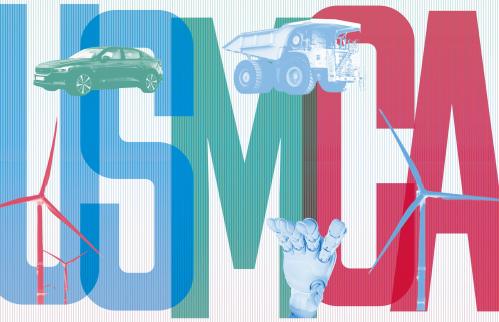In a speech at Georgetown University on June 25, President Obama finally gave extended attention to America’s policy on climate change after a long run of making only vague and passing references to the subject. He made it clear that he believes humanity faces a nearly existential crisis, and that the central question for him is “whether we will have the courage to act before it’s too late.” The plan he offered to deliver that action contained several elements, including promoting renewable energy, but the centerpiece was regulation of greenhouse gas emissions under the Clean Air Act (CAA), especially from existing power plants, which generate around 40 percent of the nation’s CO2 emissions.
Unfortunately, the regulations likely to be produced under the CAA will be inefficient; the Act, written for very different purposes, provides a singularly unsteady basis for climate change policy, as I explained in a Brookings paper last year. Even putting aside those concerns, and assuming that the EPA in Obama’s second term (and beyond) fully commits itself to regulating greenhouse gas emissions from power plants, there is likely to be a huge delay before any policy could be meaningfully implemented.
According to the President’s own timetable, a rule for existing power plants must be proposed by June 1, 2014; finalized by June 1, 2015; and produce guidelines for State Implementation Plans (SIPs) by June 30, 2016. Figure on at least another couple years for states to formulate their plans and receive approval from the EPA—or longer if some states prove recalcitrant (not exactly far-fetched) and have their SIPs disapproved by EPA, requiring either another round of proposals or the formulation of a Federal Implementation Plan. The best case scenario, then, would see effective rules on existing power plants kicking in around 2020.
In a July 16 Politico article, David Bailey and David Bookbinder lay out a timetable that is far more pessimistic for a rule that would, as some environmentalists hope, result in a quasi-cap-and-trade system regulating the nation’s carbon emissions. They suppose that the EPA can promulgate a final rule for existing power plants as fast as Obama has proposed—but then imagine that the rule might be bogged down in litigation for an additional three years before it could proceed. They estimate a total of four more years for state implementation—putting the effective date at 2022. But they also consider the possibility that litigation could hold up state implementations, as states would be reluctant to design and implement complicated emissions trading systems to hit their targets if there was a chance that their efforts would be erased by an adverse judicial ruling; and subsequent litigation over the state plans could add as much as another four years. Finally, they expect meaningful emissions reductions would take around three years to kick in once the regulatory system was operative—meaning that Obama’s proposed system, meant to initiate action “before it’s too late,” may not have bite until 2030.
Bailey and Bookbinder, now consulting partners specializing in climate change issues, bring diverse experiences to their judgment: Bailey as an economist for Exxon-Mobil, Bookbinder as a lawyer for the Sierra Club. Nevertheless, some people are likely to be skeptical of their conclusion—sixteen years from proposed rule to impact seems like an awfully long time to get a regulatory scheme off the ground, no matter how many legal kinks have to be solved.
Using my own dataset of CAA rulemakings with national applicability proposed from 1991-2009, which I collected as part of my dissertation research, I can say that the skeptical impulse is understandable. Certainly, most regulation under the CAA does not take so long. But a deeper look at the legal battles that have played out in recent decades suggest that Bailey and Bookbinder’s estimate is in the right ballpark, and almost certainly more realistic than the President’s timetable.
First, let’s look at the process of getting to a final rule in the first place. Bailey and Bookbinder accept the President’s timetable at this stage, but it will be quite difficult to keep to it. Consistent with Obama’s timetable, I estimate the average time from proposal to finalization for all rules of nationwide applicability is around a year. But this average includes a great number of rulemakings that turn out to generate minimal controversy—and we can be quite sure that an ambitious new rule governing GHG emissions from existing power plants would not fall into that category. For rules that would eventually elicit litigation, the average was more like a year and a half, as working through substantial objections takes time. (Even if the agency is determined to hold its ground against adverse comments, complying with the Administrative Procedures Act means that it must give well-reasoned rebuttals to every serious point of contention.)
It’s also worth noting that, by the time the agency makes its official proposal, it has often done a large amount of listening to industry and environmentalist concerns. Often it does so by issuing an Advanced Notice of Proposed Rulemaking (ANPR) and holding rounds of public meetings many months before it ever releases its original proposal. The EPA will not have the benefit of an ANPR in proceeding on a proposed rule for existing power plants, though, if it hopes to meet Obama’s goal of a June 2014 proposal.
The hazards of skipping that step are made evident by the recent experience with the proposed rule to regulate greenhouse gas emissions from new power plants to be built in the future. The EPA proposed a rule on March 27, 2012, and was subject to various legally-imposed deadlines to finalize the rule by April 2013. After receiving some 2.7 million comments about its proposed rule, which many people thought would effectively ban construction of new coal power plants, the agency has now decided to table its initial plan and offer a new proposal, currently under review at OMB and expected to be released in September. In other words, the time from original proposal to finalization will not possibly be less than two years, and could well be significantly more.
But let us nevertheless suppose that the EPA has learned from this bruising fight, and could figure out how to move more quickly from proposal to final rule when it comes to regulating existing power plants, so that we could have a finalized rule in mid-2015.
At that point, as Bailey and Bookbinder point out, it would simply be naïve to imagine that the final rule would not face litigation. America’s power industry remains mostly unreconciled to the development of a GHG regulatory regime under the CAA, and there is every reason to believe that they would make their complaints known in court. How long is this process likely to take?
Chains of rulemaking, litigation, follow-up rulemaking, and follow-up litigation are not a regular occurrence, but especially on economically important issues they are far from unheard-of. By my count, at least 100 different CAA rulemakings begun from 1991-2009 took three or more years to progress from proposed rule through litigation (and subsequent re-proposals, when applicable) until final efficacy, and 20 proposed rulemakings began chains that took more than eight years. A couple examples illustrate the potential difficulties of working through litigation.
A dispute about whether the CAA’s standard for sulfur dioxide (SO2) should include a requirement for five-minute-long peaks of exposure began with a proposed rule declining to issue such a standard in 1994, proceeded slowly to a final rule in 1996, then to an environmentalist court victory in 1998, a follow-up settlement designating a timetable for the EPA to respond to the court’s remand, and a subsequent settlement yielding an extension. Despite those settlements committing the agency to timely action, the issue lingered for years during the Bush 43 Administration, though a scientific assessment was finally undertaken in 2006. Only after another lawsuit to force action, and a total of almost twelve years after the original court ruling, did the agency finally respond in 2009—only to adhere to the original decision not to promulgate a 5-minute standard, this time based on more scientific evidence.[i]
Some might say that this example is rather inapposite, since it involves environmental groups suing to force the agency into action it otherwise preferred not to take. Fair enough—although given the likelihood that litigation will push the process of operationalizing an existing power plant rule into the 45th President’s administration, and the Republican Party remains opposed to developing these regulations, perhaps the possibility that environmentalists will have to wring actions out of a hostile or at least unenthusiastic administration ought to figure prominently into these calculations.
In any case, even when the agency is fully behind the development of a regulation, it may find that legal difficulties make its efforts drag out. In what may be the most instructive point of comparison for the development of a CO2 rule for existing power plants, first the Bush 43 administration and then the Obama administration attempted to develop rules supporting regional cap-and-trade systems for several conventional pollutants, thus dealing with cross-state transport of air pollution in an economically efficient manner. The Bush Administration’s attempt to create such trading markets under Title I of the Act, so as to mimic the market-based success of Title IV, yielded its Clean Air Interstate Rule (CAIR), which was one of the EPA’s top priorities. Proposed in 2004, finalized in 2005, the rule was deemed inconsistent with the language of the CAA by the D.C. Circuit in 2008.[ii] The Obama Administration’s EPA attempted to remake the rule along somewhat similar lines with its Cross-State Air Pollution Rule (the “Transport Rule”), proposed in 2010 and finalized in August 2011. In August 2012, the D.C. Circuit struck this rule down as unlawful, too, showing that the deference to agency expertise that characterizes so much of contemporary administrative law is far from unlimited.[iii] The result is that we have very little to show for nearly a decade of pursuing a regulatory scheme that most economists have only praise for. It remains to be seen what the ultimate “time to completion” for the scheme turns out to be, if indeed completing it proves possible without legislative changes.
The saga of CAIR and the Transport Rule is a cautionary tale for those who hope to make the best of the EPA’s current CAA powers to regulate greenhouse gases in this age of legislative gridlock. Sometimes, executive action simply cannot provide an effective substitute for inter-branch cooperation. At worst, years of well-meaning and possibly even well-thought-out regulatory work can come to naught.
At best, there will always be the potential for disruption from litigation. It may well be the case (though skeptics will doubt it) that the EPA, left to its own devices, would make ad hoc adjustments to the ill-fitting requirements of the statute that would ultimately produce sensible and effective regulation. But the agency will not be left alone. Instead, it is likely to find itself in court again and again, defending itself not just against industry challenges but against environmentalists who believe it is unlawfully failing to get every bit of prescribed regulation out of the statute. A recent D.C. Circuit decision overturning an EPA exemption for sources of biogenic CO2 emissions at the behest of the Center for Biological Diversity provides an instructive example.[iv] The EPA’s current approach relies on no firm or environmental group having standing to challenge its “tailoring” of the CAA to common sense proportions, but should judges find that standing does exist, the agency may be forced, on the basis of the Act’s plain language, to cover very minor emitters under its permitting regimes. Such litigation and the administrative challenges they spawn are likely to bog down an already-overburdened agency, and may produce rules that are inefficient for achieving desired reductions in CO2 emissions.
It may be that those who oppose effective measures against greenhouse gas emissions will be heartened by the prospect of delays. But the portrait painted here is hardly a happy one for them. Instead, a protracted and costly legal process promises years of regulatory uncertainty and the potential of heavy-handed regulation at the end, however distant that prospect may currently seem.
The conclusion to draw, for interested observers from all perspectives, ought to be clear: we should replace this uncertain and ungainly regulation of greenhouse gases under the Clean Air Act with a carbon tax, as laid out by my Brookings colleague Adele Morris. Far simpler than any scheme that could emerge under the CAA—and properly situated at the federal rather than state level—a carbon tax could be up and running much, much faster than the regulatory scheme likely to be pursued under the CAA. Morris estimates that, building on the IRS’s extensive experience with excise taxes (many of which, including fuel taxes, already apply to power plants and other heavy industry), we could put a nationwide carbon tax into place in about two years. One discussion draft bill posted in March 2013 would even seek to cover 2014 emissions by using the reports available through the EPA’s current greenhouse gas reporting rule.
The politics remain “a heavy lift,” as Bailey and Bookbinder put it. Many people think that the idea of getting Republican support for a proposal, the second word of which is “tax,” is risible. But they should stifle their laughter: there are growing signs that Republicans are giving a carbon tax serious consideration, especially if it is made revenue-neutral. The R Street Institute’s president, Eli Lehrer, has recently written about the promise of a carbon tax, and so has “Eric Bradenson,” a pseudonymous Republican Hill staffer who reports that some Republican members are quietly looking to change the party’s direction on climate change policy. When looking into the coming decades, members of both parties ought to soberly assess the costs of pursuing the path the President has laid out. There is a better way.
Originally published by Bloomberg Finance L.P. Reprinted with permission. The opinions expressed are those of the author.
[i] See 61 Fed. Reg. 25566 (1996); American Lung Association v. Browner, 134 F.3d 388 (D.C. Cir., 1998); settlement notices at 63 Fed. Reg. 30493, 64 Fed. Reg. 73045, 65 Fed. Reg. 77025; notice published at 71 Fed. Reg. 28023; Center for Biologic Diversity v. Johnson, Civ. No. 05-1814 (D.D.C. 2007); 74 Fed. Reg. 64810 (2009).
[ii] See 69 Fed. Reg. 4566, 69 Fed. Reg. 32684, 70 Fed. Reg. 25162; North Carolina v. EPA, 531 F.3d 896 (D.C. Cir., 2008).
[iii] 75 Fed. Reg. 45210; 76 Fed. Reg. 48208; EME Homer City Generation v. EPA, 696 F.3d 7 (2012).
[iv] Center for Biological Diversity v. EPA, No. 11-1101 (D.C. Cir., 2013) (http://www.cadc.uscourts.gov/internet/opinions.nsf/F523FF1F29C06ECA85257BA6005397B5/$file/11-1101-1446222.pdf).
The Brookings Institution is committed to quality, independence, and impact.
We are supported by a diverse array of funders. In line with our values and policies, each Brookings publication represents the sole views of its author(s).



Commentary
A Realistic Timetable for Greenhouse Gas Regulation Under the Clean Air Act
September 26, 2013